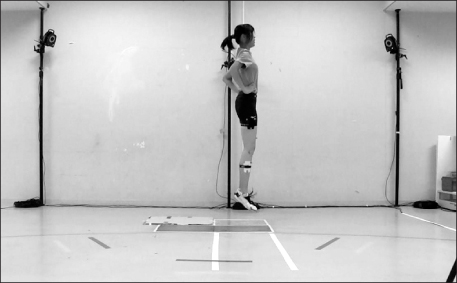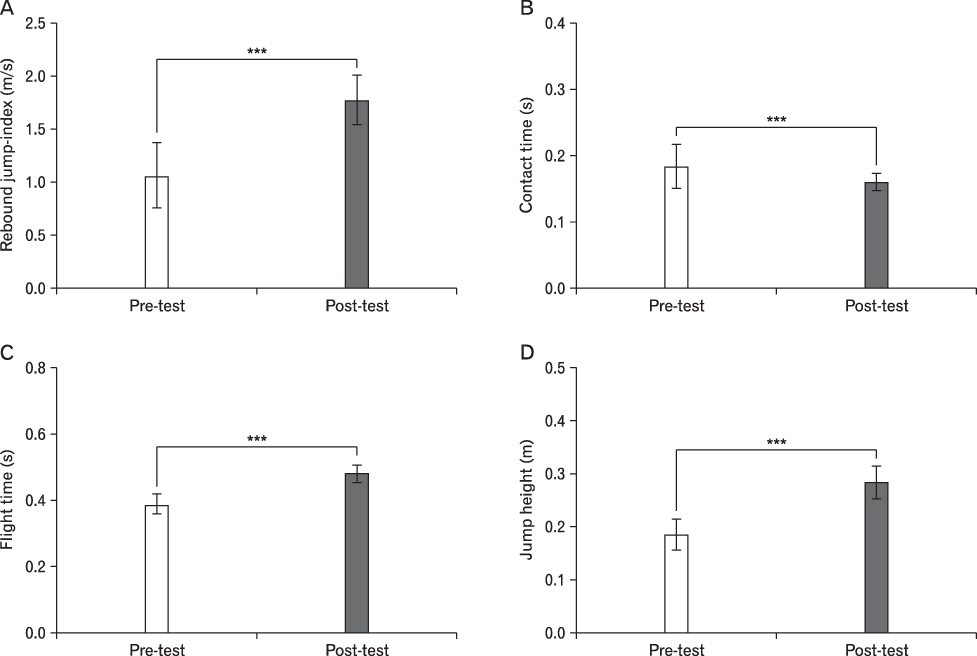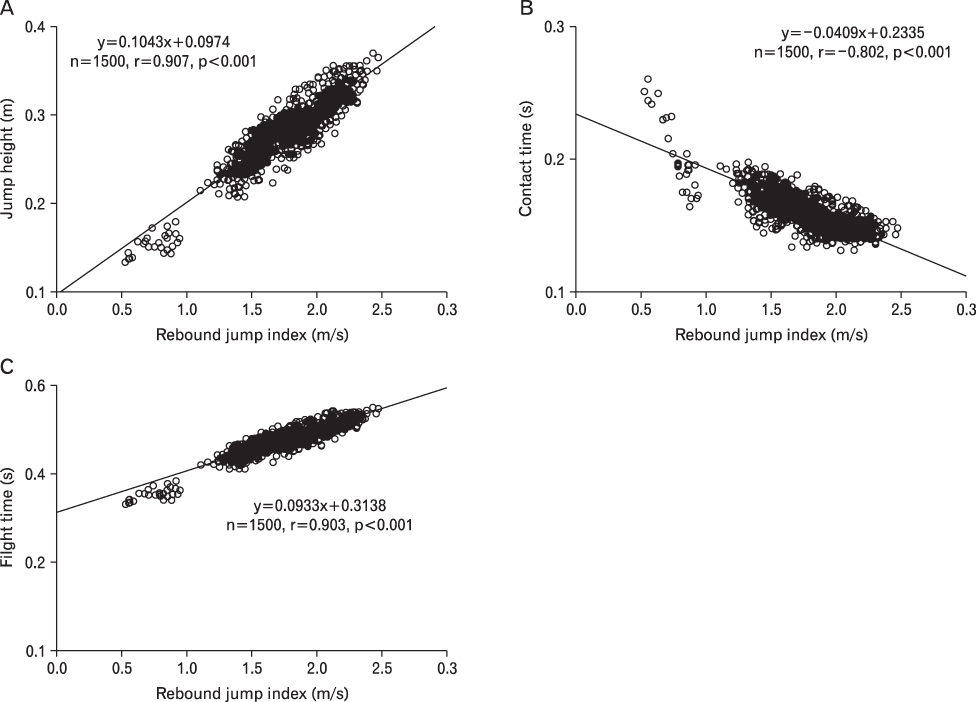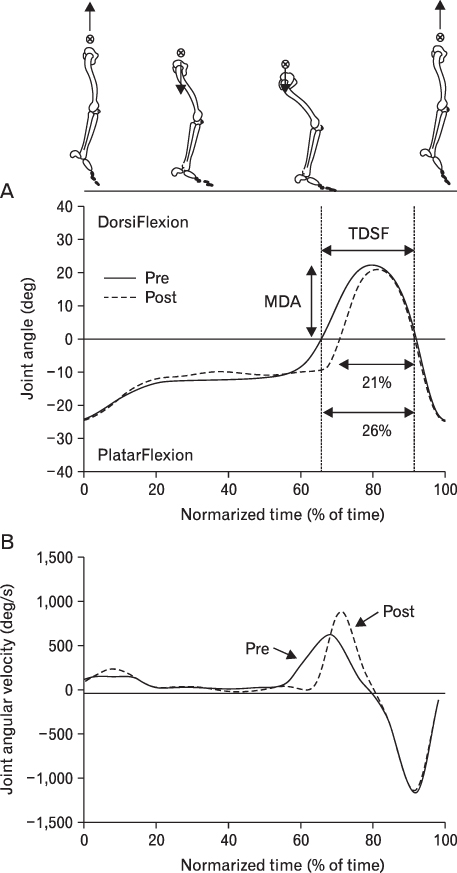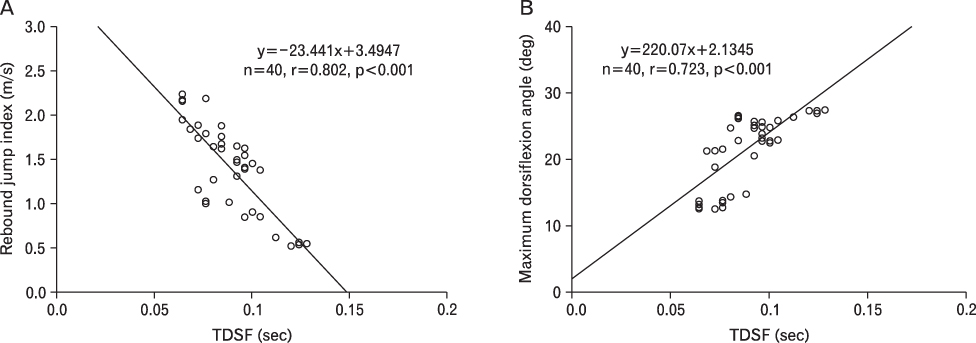Korean J Sports Med.
2012 Jun;30(1):47-54. 10.5763/kjsm.2012.30.1.47.
Effects of Plyometric Training on Ankle Joint Motion and Jump Performance
- Affiliations
-
- 1School of Sport and Health Science, Tokai Gakuen University, Miyoshi, Japan. hanulhanbyeol7374@hotmail.co.jp
- 2Department of Preventive Medicine, National Center for Geriatrics and Gerontology, Obu, Japan.
- KMID: 2288648
- DOI: http://doi.org/10.5763/kjsm.2012.30.1.47
Abstract
- The purpose of this study was to quantify the effect of plyometric training (PT) in changes of jump abilities and ankle joint motions on repeated-rebound-jumps exercise without buffer function of lower limb joints. Seven female collegiate runners executed 10-repeated rebound jumps training (10 RJ) on a switch mat with maximum effort. Each subject executed the training program twice a week for 5 consecutive weeks. Parameters of repeated-rebound jumps training involved jump height (m), the contact time (s), flight time (s), and rebound jumps index (=RJ-index). Three-dimensional ankle joint kinematics of each subject were captured using ten motion capture systems (250 Hz). As a result, RJ-index, jump height, and flight time were increased significantly between pre-and post-test (p<0.001). But, the contact time decreased significantly. The relationships between rebound jumps index and jump height and between rebound jumps index and the durations of contact phase were highly correlated (r=0.858, r=-0.739; p<0.001). In addition, the time (%) between start and finish phase in the dorsiflexion angle of ankle joint was reduced significantly between pre-and post-test (p<0.001). The repeated-rebound-jumps exercise was shown to have an effect on improvement in stretch-shortening cycle (SSC) performance of lower limb joints in distance runners. The RJ-index and the time between start and finish phase in the dorsiflexion angle of ankle joint was shown to be a valid evaluation index of SSC performance. Therefore, repeated-rebound-jumps exercise is a significant training protocol where ankle behavior improves and where the performance of stretch-shortening cycle is enhanced.
Figure
Reference
-
1. Herrero JA, Izquierdo M, Maffiuletti NA, Garcia-Lopez J. Electromyostimulation and plyometric training effects on jumping and sprint time. Int J Sports Med. 2006. 27:533–539.2. Kubo K, Morimoto M, Komuro T, et al. Effects of plyometric and weight training on muscle-tendon complex and jump performance. Med Sci Sports Exerc. 2007. 39:1801–1810.3. Arabatzi F, Kellis E, Saez-Saez De Villarreal E. Vertical jump biomechanics after plyometric, weight lifting, and combined (weight lifting + plyometric) training. J Strength Cond Res. 2010. 24:2440–2448.4. Wu YK, Lien YH, Lin KH, Shih TT, Wang TG, Wang HK. Relationships between three potentiation effects of plyometric training and performance. Scand J Med Sci Sports. 2010. 20:e80–e86.5. Wilson GJ, Newton RU, Murphy AJ, Humphries BJ. The optimal training load for the development of dynamic athletic performance. Med Sci Sports Exerc. 1993. 25:1279–1286.6. Young W, McLean B, Ardagna J. Relationship between strength qualities and sprinting performance. J Sports Med Phys Fitness. 1995. 35:13–19.7. Zushi K, Takamatsu K, Takayoshi K. The specificity of leg strength and power in several sport athletes. Jpn Soc Phy Educ. 1993. 38:265–278.8. Yu B, Gabriel D, Noble L, An KN. Estimate of the Optimum cutoff frequency for the butterworth low-pass digital filter. J Appl Biomech. 1999. 13:318–329.9. Winter DA. Biomechanics and motor control of human movement. 1990. New York: Wiley.10. Cole GK, Nigg BM, Ronsky JL, Yeadon MR. Application of the joint coordinate system to three-dimensional joint attitude and movement representation: a standardization proposal. J Biomech Eng. 1993. 115:344–349.11. Areblad M, Nigg BM, Ekstrand J, Olsson KO, Ekstrom H. Three-dimensional measurement of rearfoot motion during running. J Biomech. 1990. 23:933–940.12. Young W, Wilson G, Byrne C. Relationship between strength qualities and performance in standing and run-up vertical jumps. J Sports Med Phys Fitness. 1999. 39:285–293.13. Zushi K, Takamatsu K. Determinants of ability to achieve ballistic stretch-shortening cycle movement: with special reference to strength and power. Jpn J Phys Fit Med. 1995. 44:147–154.14. Zushi K, Takamatsu K. Factors to shorten the contact time in rebound drop jump: with special reference to work done by the lower limb joints and anticipation of the landing. Jpn Soc Phy Educ. 1995. 40:29–39.15. Delecluse C. Influence of strength training on sprint running performance. Current findings and implications for training. Sports Med. 1997. 24:147–156.16. Tsiokanos A, Kellis E, Jamurtas A, Kellis S. The relationship between jumping performance and isokinetic strength of hip and knee extensors and ankle plantar flexors. Isokinet Exerc Sci. 2002. 10:107–115.17. Fukashiro S, Kobayashi T, Wakayama A, Yanagi H, Kojima T. The comparison of power output developed with selected vertical jumps to two ergometer test. Jpn J Sports Sci. 1993. 12:326–332.18. Chelly SM, Denis C. Leg power and hopping stiffness: relationship with sprint running performance. Med Sci Sports Exerc. 2001. 33:326–333.19. Iwatake J, Suzuki T, Nakamura N, Oda H, Nagasawa T, Iwakabe T. Relationship between anaerobic power on rebound jump and sprint running performance in track and field athletes. Res Phys Educ. 2002. 47:253–261.20. Komi PV. Jones NL, McCartney N, McComas AJ, editors. The stretch-shortening cycle and human power output. Human muscle power. 1986. Champaign (IL): Human kinetics;27–39.21. Cavagna GA, Saibene FP, Margaria R. Effect of negative work on the amount of positive work performed by an isolated muscle. J Appl Physiol. 1965. 20:157–158.22. Komi P. Cerquiclini S, Venerando A, Wartenweiler J, editors. Measurement of the force-velocity relationship in human muscle under concentric and eccentric contractions. Medicine and sport series. 1973. Vol. 8, Biomechanics III. Basel: Karger;224–229.
- Full Text Links
- Actions
-
Cited
- CITED
-
- Close
- Share
- Similar articles
-
- Range of Motion of the Ankle According to Pushing Force, Gender and Knee Position
- Comparing Ankle Range of Motion, Functional Ability, Talar Tilt Angle and Foot Injuries between High School Ballet Majors with and without Foot Deformities
- Effect of Cryotherapy on Muscle Strength and Balance on the Ankle Joint in Patients with Stroke
- The Prevention and Rehabilitation of Soccer Injuries
- The Function and Symptoms of Ankle Joint in the Distal Tibial Fractures Treated by Nailing

